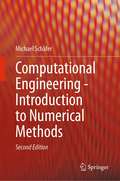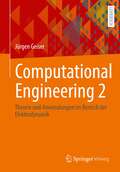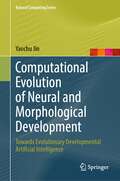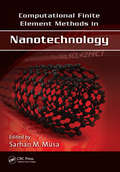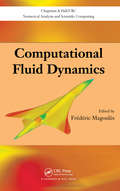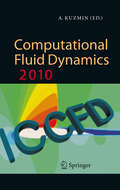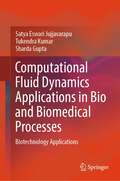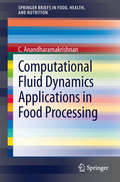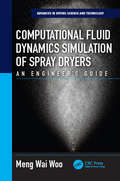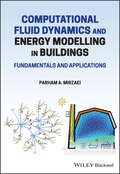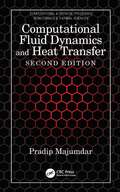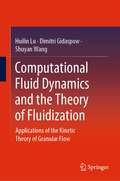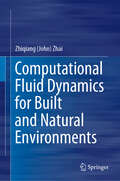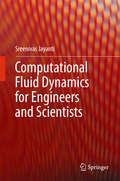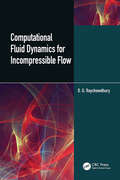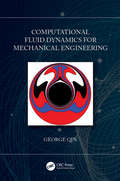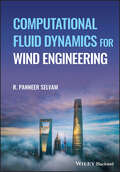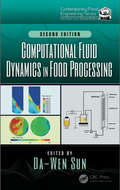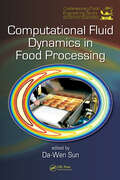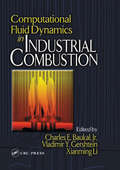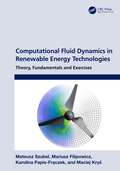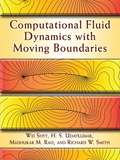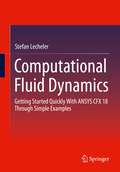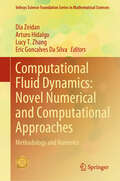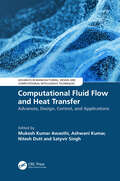- Table View
- List View
Computational Engineering - Introduction to Numerical Methods
by Michael SchäferNumerical simulation methods in all engineering disciplines gains more and more importance.The successful and efficient application of such tools requires certain basic knowledge about the underlying numerical techniques.The text gives a practice-oriented introduction in modern numerical methods as they typically are applied in mechanical, chemical, or civil engineering. Problems from heat transfer, structural mechanics, and fluid mechanics constitute a thematical focus of the text.For the basic understanding of the topic aspects of numerical mathematics, natural sciences, computer science, and the corresponding engineering area are simultaneously important. Usually, the necessary information is distributed in different textbooks from the individual disciplines. In the present text the subject matter is presented in a comprehensive multidisciplinary way, where aspects from the different fields are treated insofar as it is necessary for general understanding. Overarching aspects and important questions related to accuracy, efficiency, and cost effectiveness are discussed.The topics are presented in an introductory manner, such that besides basic mathematical standard knowledge in analysis and linear algebra no further prerequisites are necessary. The book is suitable either for self-study or as an accompanying textbook for corresponding lectures. It can be useful for students of engineering disciplines as well as for computational engineers in industrial practice.
Computational Engineering 2: Theorie und Anwendungen im Bereich der Elektrodynamik
by Jürgen GeiserDas Buch zeigt Theorie und praktische Anwendungen im Bereich des Computational Engineering (berechnendes Ingenieurwesen) für elektrodynamische Anwendungen. Es illustriert sowohl die mathematischen Modelle wie auch die zugehörigen Simulationsmethoden für die verschiedenen Ingenieursanwendungen. Außerdem präsentiert es Strategien zur Verbesserung der numerischen Methoden wie z. B. Zeit-Raum-Verfahren, hyperbolische Löser, Multiskalenlöser oder strukturerhaltende Verfahren sowie Kopplungsverfahren für elektrodynamische und hydrodynamische Modelle auf verschiedenen Zeit- und Raumskalen. Dabei werden Ansätze zur Zerlegung in einfachere und effizient lösbare Teilprobleme vorgestellt. Gerade im Bereich der Multikomponenten- und Multiskalenmodelle bei komplizierten Ingenieursproblemen sind solche neuartigen Multiskalenverfahren wichtig. Weiter werden auch stochastische Modelle im Bereich der Partikelmodelle und deren Einbindung in deterministische Modelle besprochen. Diese neueren Problemstellungen brauchen iterative Löser zur Kopplung der verschiedenen Zeit- und Raumskalen. Die umfangreichen Beispiele aus dem Bereich der Elektrodynamik (inkl. elektromagnetische Felder, Antennenmodelle, Teilchenmodelle im Bereich der Plasmasimulation) geben dem Leser einen Überblick zu den aktuellen Themen und deren praktischer Umsetzung in spätere Simulationsprogramme.
Computational Evolution of Neural and Morphological Development: Towards Evolutionary Developmental Artificial Intelligence (Natural Computing Series)
by Yaochu JinThis book provides a basic yet unified overview of theory and methodologies for evolutionary developmental systems. Based on the author’s extensive research into the synergies between various approaches to artificial intelligence including evolutionary computation, artificial neural networks, and systems biology, it also examines the inherent links between biological intelligence and artificial intelligence. The book begins with an introduction to computational algorithms used to understand and simulate biological evolution and development, including evolutionary algorithms, gene regulatory network models, multi-cellular models for neural and morphological development, and computational models of neural plasticity. Chap. 2 discusses important properties of biological gene regulatory systems, including network motifs, network connectivity, robustness and evolvability. Going a step further, Chap. 3 presents methods for synthesizing regulatory motifs from scratch and creating more complex regulatory dynamics by combining basic regulatory motifs using evolutionary algorithms. Multi-cellular growth models, which can be used to simulate either neural or morphological development, are presented in Chapters 4 and 5. Chap. 6 examines the synergies and coupling between neural and morphological evolution and development. In turn, Chap. 7 provides preliminary yet promising examples of how evolutionary developmental systems can help in self-organized pattern generation, referred to as morphogenetic self-organization, highlighting the great potentials of evolutionary developmental systems. Finally, Chap. 8 rounds out the book, stressing the importance and promise of the evolutionary developmental approach to artificial intelligence. Featuring a wealth of diagrams, graphs and charts to aid in comprehension, this book offers a valuable asset for graduate students, researchers and practitioners who are interested in pursuing a different approach to artificial intelligence.
Computational Finite Element Methods in Nanotechnology
by Sarhan M. MusaComputational Finite Element Methods in Nanotechnology demonstrates the capabilities of finite element methods in nanotechnology for a range of fields. Bringing together contributions from researchers around the world, it covers key concepts as well as cutting-edge research and applications to inspire new developments and future interdisciplinary research. In particular, it emphasizes the importance of finite element methods (FEMs) for computational tools in the development of efficient nanoscale systems. The book explores a variety of topics, including: A novel FE-based thermo-electrical-mechanical-coupled model to study mechanical stress, temperature, and electric fields in nano- and microelectronics The integration of distributed element, lumped element, and system-level methods for the design, modeling, and simulation of nano- and micro-electromechanical systems (N/MEMS) Challenges in the simulation of nanorobotic systems and macro-dimensions The simulation of structures and processes such as dislocations, growth of epitaxial films, and precipitation Modeling of self-positioning nanostructures, nanocomposites, and carbon nanotubes and their composites Progress in using FEM to analyze the electric field formed in needleless electrospinning How molecular dynamic (MD) simulations can be integrated into the FEM Applications of finite element analysis in nanomaterials and systems used in medicine, dentistry, biotechnology, and other areas The book includes numerous examples and case studies, as well as recent applications of microscale and nanoscale modeling systems with FEMs using COMSOL Multiphysics® and MATLAB®. A one-stop reference for professionals, researchers, and students, this is also an accessible introduction to computational FEMs in nanotechnology for those new to the field.
Computational Fluid Dynamics (Chapman & Hall/CRC Numerical Analysis and Scientific Computing Series)
by Frédéric MagoulèsExploring new variations of classical methods as well as recent approaches appearing in the field, Computational Fluid Dynamics demonstrates the extensive use of numerical techniques and mathematical models in fluid mechanics. It presents various numerical methods, including finite volume, finite difference, finite element, spectral, smoothed parti
Computational Fluid Dynamics 2010: Proceedings of the Sixth International Conference on Computational Fluid Dynamics, ICCFD6, St Petersburg, Russia, on July 12-16, 2010
by Alexander KuzminThe International Conference on Computational Fluid Dynamics is held every two years and brings together physicists, mathematicians and engineers to review and share recent advances in mathematical and computational techniques for modeling fluid flow. The proceedings of the 2010 conference (ICCFD6) held in St Petersburg, Russia, contain a selection of refereed contributions and are meant to serve as a source of reference for all those interested in the state of the art in computational fluid dynamics.
Computational Fluid Dynamics Applications in Bio and Biomedical Processes: Biotechnology Applications
by Satya Eswari Jujjavarapu Tukendra Kumar Sharda GuptaThis book covers emerging areas in novel design and their hydrodynamic properties relevant to bioreactors, environmental system, electrochemical systems, food processing and biomedical engineering. This book uses an interdisciplinary approach to provide a comprehensive prospective simulation modeling and hydrodynamic study in advanced biotechnological process and includes reviews of the most recent state of art in modeling and simulation of flows in biological process, such as CFD. Written by internationally recognized researchers in the field, each chapter provides a strong introductory section that is useful to both readers currently in the field and readers interested in learning more about these areas.
Computational Fluid Dynamics Applications in Food Processing (SpringerBriefs in Food, Health, and Nutrition)
by C. AnandharamakrishnanComputational Fluid Dynamics (CFD) has been applied extensively to great benefit in the food processing sector. Its numerous applications include: predicting the gas flow pattern and particle histories, such as temperature, velocity, residence time, and impact position during spray drying; modeling of ovens to provide information about temperature and airflow pattern throughout the baking chamber to enhance heat transfer and in turn final product quality; designing hybrid heating ovens, such as microwave-infrared, infrared-electrical or microwave-electrical ovens for rapid baking; model the dynamics of gastrointestinal contents during digestion based on the motor response of the GI tract and the physicochemical properties of luminal contents; retort processing of canned solid and liquid foods for understanding and optimization of the heat transfer processes. This Brief will recapitulate the various applications of CFD modeling, discuss the recent developments in this field, and identify the strengths and weaknesses of CFD when applied in the food industry.
Computational Fluid Dynamics Simulation of Spray Dryers: An Engineer’s Guide (Advances in Drying Science and Technology #Vol. 2)
by Meng Wai WooBridging the gap in understanding between the spray drying industry and the numerical modeler on spray drying, Computational Fluid Dynamics Simulation of Spray Dryers: An Engineer’s Guide shows how to numerically capture important physical phenomena within a spray drying process using the CFD technique. It includes numerical strategies to effectively describe these phenomena, which are collated from research work and CFD industrial consultation, in particular to the dairy industry. Along with showing how to set up models, the book helps readers identify the capabilities and uncertainties of the CFD technique for spray drying. After briefly covering the basics of CFD, the book discusses airflow modeling, atomization and particle tracking, droplet drying, quality modeling, agglomeration and wall deposition modeling, and simulation validation techniques. The book also answers questions related to common challenges in industrial applications.
Computational Fluid Dynamics and Energy Modelling in Buildings: Fundamentals and Applications
by Parham A. MirzaeiCOMPUTATIONAL FLUID DYNAMICS AND ENERGY MODELLING IN BUILDINGS A Comprehensive Overview of the Fundamentals of Heat and Mass Transport Simulation and Energy Performance in Buildings In the first part of Computational Fluid Dynamics and Energy Modelling in Buildings: Fundamentals and Applications, the author explains the fundamentals of fluid mechanics, thermodynamics, and heat transfer, with a specific focus on their application in buildings. This background knowledge sets the scene to further model heat and mass transport in buildings, with explanations of commonly applied simplifications and assumptions. In the second part, the author elaborates how the fundamentals explained in part 1 can be used to model energy flow in buildings, which is the basis of all commercial and educational building energy simulation tools. An innovative illustrative nodal network concept is introduced to help readers comprehend the basics of conservation laws in buildings. The application of numerical techniques to form dynamic simulation tools are then introduced. In general, understanding these techniques will help readers to identify and justify their choices when working with building energy simulation tools, rather than using default settings. Detailed airflow information in buildings cannot be obtained in building energy simulation techniques. Therefore, part three is focused on introducing computational fluid dynamics (CFD) as a detailed modelling technique for airflow in buildings. This part starts with an introduction to the fundamentals of the finite volume method used to solve the governing fluid equations and the related challenges and considerations are discussed. The last chapter of this part covers the solutions to some practical problems of airflow within and around buildings. The key aspect of Computational Fluid Dynamics and Energy Modelling in Buildings: Fundamentals and Applications is that it is tailored for audiences without extensive past experience of numerical methods. Undergraduate or graduate students in architecture, urban planning, geography, architectural engineering, and other engineering fields, along with building performance and simulation professionals, can use this book to gain additional clarity on the topics of building energy simulation and computational fluid dynamics.
Computational Fluid Dynamics and Heat Transfer (Series In Computational And Physical Processes In Mechanics And Thermal Sciences Ser.)
by Pradip MajumdarThis book provides a thorough understanding of fluid dynamics and heat and mass transfer. The Second Edition contains new chapters on mesh generation and computational modeling of turbulent flow. Combining theory and practice in classic problems and computer code, the text includes numerous worked-out examples. Students will be able to develop computational analysis models for complex problems more efficiently using commercial codes such as ANSYS, STAR CCM+, and COMSOL. With detailed explanations on how to implement computational methodology into computer code, students will be able to solve complex problems on their own and develop their own customized simulation models, including problems in heat transfer, mass transfer, and fluid flows. These problems are solved and illustrated in step-by-step derivations and figures. FEATURES Provides unified coverage of computational heat transfer and fluid dynamics Covers basic concepts and then applies computational methods for problem analysis and solution Covers most common higher-order time-approximation schemes Covers most common and advanced linear solvers Contains new chapters on mesh generation and computer modeling of turbulent flow Computational Fluid Dynamics and Heat Transfer, Second Edition, is valuable to engineering instructors and students taking courses in computational heat transfer and computational fluid dynamics.
Computational Fluid Dynamics and the Theory of Fluidization: Applications of the Kinetic Theory of Granular Flow
by Dimitri Gidaspow Huilin Lu Shuyan WangThis book is for engineers and students to solve issues concerning the fluidized bed systems. It presents an analysis that focuses directly on the problem of predicting the fluid dynamic behavior which empirical data is limited or unavailable. The second objective is to provide a treatment of computational fluidization dynamics that is readily accessible to the non-specialist. The approach adopted in this book, starting with the formulation of predictive expressions for the basic conservation equations for mass and momentum using kinetic theory of granular flow. The analyses presented in this book represent a body of simulations and experiments research that has appeared in numerous publications over the last 20 years. This material helps to form the basis for university course modules in engineering and applied science at undergraduate and graduate level, as well as focused, post-experienced courses for the process, and allied industries.
Computational Fluid Dynamics for Built and Natural Environments
by Zhiqiang (John) ZhaiThis book introduces readers to the fundamentals of simulating and analyzing built and natural environments using the Computational Fluid Dynamics (CFD) method. CFD offers a powerful tool for dealing with various scientific and engineering problems and is widely used in diverse industries. This book focuses on the most important aspects of applying CFD to the study of urban, buildings, and indoor and outdoor environments. Following the logical procedure used to prepare a CFD simulation, the book covers e.g. the governing equations, boundary conditions, numerical methods, modeling of different fluid flows, and various turbulence models. Furthermore, it demonstrates how CFD can be applied to solve a range of engineering problems, providing detailed hands-on exercises on air and water flow, heat transfer, and pollution dispersion problems that typically arise in the study of buildings and environments. The book also includes practical guidance on analyzing and reporting CFD results, as well as writing CFD reports/papers.
Computational Fluid Dynamics for Engineers and Scientists
by Sreenivas JayantiThis book offers a practical, application-oriented introduction to computational fluid dynamics (CFD), with a focus on the concepts and principles encountered when using CFD in industry. Presuming no more knowledge than college-level understanding of the core subjects, the book puts together all the necessary topics to give the reader a comprehensive introduction to CFD. It includes discussion of the derivation of equations, grid generation and solution algorithms for compressible, incompressible and hypersonic flows. The final two chapters of the book are intended for the more advanced user. In the penultimate chapter, the special difficulties that arise while solving practical problems are addressed. Distinction is made between complications arising out of geometrical complexity and those arising out of the complexity of the physics (and chemistry) of the problem. The last chapter contains a brief discussion of what can be considered as the Holy Grail of CFD, namely, finding the optimal design of a fluid flow component. A number of problems are given at the end of each chapter to reinforce the concepts and ideas discussed in that chapter. CFD has come of age and is widely used in industry as well as in academia as an analytical tool to investigate a wide range of fluid flow problems. This book is written for two groups: for those students who are encountering CFD for the first time in the form of a taught lecture course, and for those practising engineers and scientists who are already using CFD as an analysis tool in their professions but would like to deepen and broaden their understanding of the subject.
Computational Fluid Dynamics for Incompressible Flows
by D.G. RoychowdhuryThis textbook covers fundamental and advanced concepts of computational fluid dynamics, a powerful and essential tool for fluid flow analysis. It discusses various governing equations used in the field, their derivations, and the physical and mathematical significance of partial differential equations and the boundary conditions. It covers fundamental concepts of finite difference and finite volume methods for diffusion, convection-diffusion problems both for cartesian and non-orthogonal grids. The solution of algebraic equations arising due to finite difference and finite volume discretization are highlighted using direct and iterative methods. Pedagogical features including solved problems and unsolved exercises are interspersed throughout the text for better understanding. The textbook is primarily written for senior undergraduate and graduate students in the field of mechanical engineering and aerospace engineering, for a course on computational fluid dynamics and heat transfer. The textbook will be accompanied by teaching resources including a solution manual for the instructors. Written clearly and with sufficient foundational background to strengthen fundamental knowledge of the topic. Offers a detailed discussion of both finite difference and finite volume methods. Discusses various higher-order bounded convective schemes, TVD discretisation schemes based on the flux limiter essential for a general purpose CFD computation. Discusses algorithms connected with pressure-linked equations for incompressible flow. Covers turbulence modelling like k-ε, k-ω, SST k-ω, Reynolds Stress Transport models. A separate chapter on best practice guidelines is included to help CFD practitioners.
Computational Fluid Dynamics for Mechanical Engineering
by George QinThis textbook presents the basic methods, numerical schemes, and algorithms of computational fluid dynamics (CFD). Readers will learn to compose MATLAB® programs to solve realistic fluid flow problems.Newer research results on the stability and boundedness of various numerical schemes are incorporated. The book emphasizes large eddy simulation (LES) in the chapter on turbulent flow simulation besides the two-equation models. Volume of fraction (VOF) and level-set methods are the focus of the chapter on two-phase flows.The textbook was written for a first course in computational fluid dynamics (CFD) taken by undergraduate students in a Mechanical Engineering major.Access the Support Materials: https://www.routledge.com/9780367687298.
Computational Fluid Dynamics for Wind Engineering
by R. Panneer SelvamCOMPUTATIONAL FLUID DYNAMICS FOR WIND ENGINEERING An intuitive and comprehensive exploration of computational fluid dynamics in the study of wind engineering Computational Fluid Dynamics for Wind Engineering provides readers with a detailed overview of the use of computational fluid dynamics (CFD) in understanding wind loading on structures, a problem becoming more pronounced as urban density increases and buildings become larger. The work emphasizes the application of CFD to practical problems in wind loading and helps readers understand important associated factors such as turbulent flow around buildings and bridges. The author, with extensive research experience in this and related fields, offers relevant and engaging practice material to help readers learn and retain the concepts discussed, and each chapter includes accessible summaries at the end. In addition, the use of the OpenFOAM tool—an open-source wind engineering application—is explored. Computational Fluid Dynamics for Wind Engineering covers topics such as: Fluid mechanics, turbulence in fluid mechanics, turbulence modelling, and mathematical modelling of wind engineering problems The finite difference method for CFD, solutions to the incompressible Navier-Stokes equations, visualization, and animation in CFD, and the application of CFD to building and bridge aerodynamics How to compare CFD analysis with wind tunnel measurements, field measurements, and the ASCE-7 pressure coefficients Wind effects and strain on large structures Providing comprehensive coverage of how CFD can explain wind load on structures along with helpful examples of practical applications, Computational Fluid Dynamics for Wind Engineering serves as an invaluable resource for senior undergraduate students, graduate students, researchers and practitioners of civil and structural engineering.
Computational Fluid Dynamics in Food Processing (Contemporary Food Engineering)
by Da-Wen SunSince many processes in the food industry involve fluid flow and heat and mass transfer, Computational Fluid Dynamics (CFD) provides a powerful early-stage simulation tool for gaining a qualitative and quantitative assessment of the performance of food processing, allowing engineers to test concepts all the way through the development of a process or system. <P><P>Published in 2007, the first edition was the first book to address the use of CFD in food processing applications, and its aims were to present a comprehensive review of CFD applications for the food industry and pinpoint the research and development trends in the development of the technology; to provide the engineer and technologist working in research, development, and operations in the food industry with critical, comprehensive, and readily accessible information on the art and science of CFD; and to serve as an essential reference source to undergraduate and postgraduate students and researchers in universities and research institutions. This will continue to be the purpose of this second edition. <P><P>In the second edition, in order to reflect the most recent research and development trends in the technology, only a few original chapters are updated with the latest developments. Therefore, this new edition mostly contains new chapters covering the analysis and optimization of cold chain facilities, simulation of thermal processing and modeling of heat exchangers, and CFD applications in other food processes.
Computational Fluid Dynamics in Food Processing (Contemporary Food Engineering)
by Da-Wen SunThe implementation of early-stage simulation tools, specifically computational fluid dynamics (CFD), is an international and interdisciplinary trend that allows engineers to computer-test concepts all the way through the development of a process or system. With the enhancement of computing power and efficiency, and the availability of affordable CF
Computational Fluid Dynamics in Industrial Combustion
by Charles E. Baukal Vladimir Y. Cershtein Xianming LiAlthough many books have been written on computational fluid dynamics (CFD) and many written on combustion, most contain very limited coverage of the combination of CFD and industrial combustion. Furthermore, most of these books are written at an advanced academic level, emphasize theory over practice, and provide little help to engineers who need
Computational Fluid Dynamics in Renewable Energy Technologies: Theory, Fundamentals and Exercises
by Mateusz Szubel Mariusz Filipowicz Karolina Papis-Frączek Maciej KryśThis book is focused on combining the concepts of computational fluid dynamics (CFD) and renewable energy technologies. Besides introducing the fundamentals, the core of this book contains a series of practical examples providing useful information about the methods and smart solutions for CFD modeling of selected Renewable Energy Sources (RES) - based technologies. Each chapter includes a theoretical introduction to the discussed topic, descriptions of factors determining efficiency and other important parameters, followed by practical information concerning the CFD modeling methodology. A summary of the relevant recommendations and exemplary results with comments is also included. Features: provides practical examples on the application of numerical methods in the analysis of renewable energy processes, includes an introduction to CFD for practitioners, explores selected aspects of the methodology used in CFD simulations of renewable energy technologies, discusses tips and hints for efficient use of CFD codes functionalities, contains additional exercise devoted to the geothermal systems. This book is aimed at professionals and graduate students in energy engineering, renewable energy, CFD, energy systems, fluid mechanics and applied mathematics.
Computational Fluid Dynamics with Moving Boundaries (Dover Books on Engineering)
by H. S. Udaykumar Wei Shyy Madhukar M. Rao Richard W. SmithThis text describes several computational techniques that can be applied to a variety of problems in thermo-fluid physics, multi-phase flow, and applied mechanics involving moving flow boundaries. Step-by-step discussions of numerical procedures include multiple examples that employ algorithms in problem-solving.In addition to its survey of contemporary numerical techniques, this volume discusses formulation and computation strategies as well as applications in many fields. Researchers and professionals in aerospace, chemical, mechanical, and materials engineering will find it a valuable resource. It is also an appropriate textbook for advanced courses in fluid dynamics, computation fluid dynamics, heat transfer, and numerical methods.
Computational Fluid Dynamics: Getting Started Quickly With ANSYS CFX 18 Through Simple Examples
by Stefan LechelerThis textbook and exercise book is aimed at future users of computational fluid dynamics software. In addition to the comprehensibly presented basics, the focus is on technical examples treated in detail with supplementary practical hints. Comprehension questions including applications give the beginner confidence in fundamental relationships. The original 4th German edition has been adapted to the latest program version ANSYS 18.1.
Computational Fluid Dynamics: Methodology and Numerics (Infosys Science Foundation Series)
by Dia Zeidan Lucy T. Zhang Eric Goncalves Da Silva Arturo HidalgoThis book reveals the latest research outputs in computational fluid dynamics. It contains selected chapters on fluid flow problems authored by international researchers. It highlights the current trends in the modelling and simulation aspects of fluid dynamics. Even though modelling and simulations in fluid dynamics are now considered mainstream in analysing fluid flows, heat and mass transfer problems, researchers are still exploring various numerical approaches and recipes to achieve better accuracy and efficiency for challenging applications in biomedical, aerospace, renewable energy and other industrial engineering applications. The book aims to bring many of the diverse modelling and simulation tools in one place and to advance existing progress in the emerging sciences of fluid dynamics. It summarizes current mathematical and physical modelling approaches as well as computational techniques applicable to fluid dynamics. The book would be of special interest to physicists and researchers in several fields related to computational, applied sciences and engineering.
Computational Fluid Flow and Heat Transfer: Advances, Design, Control, and Applications (Advances in Manufacturing, Design and Computational Intelligence Techniques)
by Ashwani Kumar Mukesh Kumar Awasthi Nitesh Dutt Satyvir SinghThe text provides insight into the different mathematical tools and techniques that can be applied to the analysis and numerical computations of flow models. It further discusses important topics such as the heat transfer effect on boundary layer flow, modeling of flows through porous media, anisotropic polytrophic gas model, and thermal instability in viscoelastic fluids.This book: Discusses modeling of Rayleigh-Taylor instability in nanofluid layer and thermal instability in viscoelastic fluids Covers open FOAM simulation of free surface problems, and anisotropic polytrophic gas model Highlights the Sensitivity Analysis in Aerospace Engineering, MHD Flow of a Micropolar Hybrid Nanofluid, and IoT-Enabled Monitoring for Natural Convection Presents thermal behavior of nanofluid in complex geometries and heat transfer effect on Boundary layer flow Explains natural convection heat transfer in non-Newtonian fluids and homotropy series solution of the boundary layer flow Illustrates modeling of flows through porous media and investigates Shock-driven Richtmyer-Meshkov instability It is primarily written for senior undergraduate, graduate students, and academic researchers in the fields of Applied Sciences, Mechanical Engineering, Manufacturing Engineering, Production Engineering, Industrial engineering, Automotive engineering, and Aerospace engineering.
